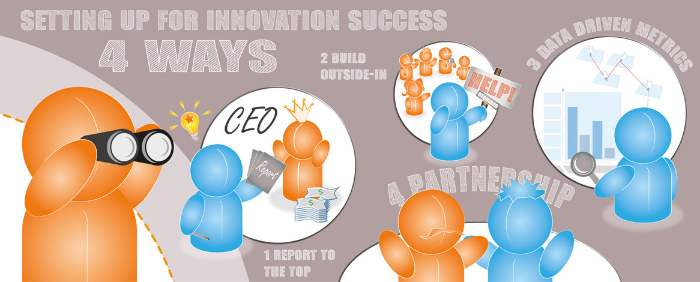I wrote recently about the need for a corporate innovation team dedicated to disruptive or transformational innovation (you can read the full article here). But given their different remits transformational teams have compared to core innovation and R&D teams, how do you set up a transformational innovation group for success?
From my own experience and those of corporate innovation leaders I’ve worked closely with, some of the most important factors to setting up a successful innovation team are:
1. Report to the top (NOT to brand, divisional or R&D leadership)
I think the most important single factor for (successful) transformational innovation groups is a dedicated leader who reports to the CEO (or even better the Chairperson). Not only does this hotline to the top bring access to funding and resources for the team but more importantly it provides the CEO an ability to deliver on the parts of their long-term strategic vision which require change to the organisation as it is today such as new brands, new markets and new business models. Without this mutually beneficial link to align strategic goals with action, innovating outside an organisation’s current business will always run into the corporate immunity protecting what it is doing today.
2. Build outside-in (DON’T just re-organise and rename internal teams)
By its nature the transformational innovation team will focus on exploring and developing new opportunities outside of the company’s core innovation pipeline – you need to build it the same way too. Team members from outside the current corporate culture and ideally even outside your industry can provide an independent perspective, challenge corporate assumptions and will bring external connections that allow you to break from corporate norms and create breakthrough. Of course it is not about separation entirely – as Safi Bahcal describes most eloquently in his book Loonshots, you need to ensure this team is also connected enough that new ideas and projects can be transferred to core R&D if and when the time is right.
3. Adopt data driven innovation metrics (DON’T measure the team in the same way as core R&D)
A common theme for disruptive innovation teams is their systematic use of data for guiding decisions and reporting results. Because you’ll be working in areas that are inherently unfamiliar to your company’s core business, investment decisions need to be driven by evidence-based market tests, and not just revenue. Metrics are never easy to get right and they should evolve over time. Early on measuring teams for action and engagement (ideas, connections, IP) can be helpful to stimulate the right behaviours. As the function matures measures should change to reflect how activities are prioritised and their impact on the wider organisation, and ultimately you’d like to see metrics that relate to business impact – although these should still be different to your core R&D teams (e.g. longer term, more speculative). I’ve even seen companies using “investment lost” as a measure of the size of experiments and learning it wanted to drive!
Don’t limit yourself with incremental annual budgeting, beyond a working discretionary budget you should need to earn significant new innovation investments. The funding should be available and protected but only provided when you meet key data driven goals. By linking the metrics with data and funding it drives discipline in innovation management and can help avoid those zombie projects.
Incidentally, many teams I’m working with are increasingly using OKRs (Objectives and Key Results) as opposed to traditional KPIs, if you’ve not come across OKRs before you can read more about them here: www.whatmatters.com
4. Explore other routes to market (DON’T constrain yourself by today’s supply chain)
One of the most limiting factors for innovation teams is sometimes the assumption that a new innovation must be delivered internally (and often using the same business model). Unlike a sustaining innovation approach, the route to market you use for each type of transformational innovation opportunity might be different. For example, some might be rapidly handed over for development and launch within the company’s existing R&D pipeline. Whilst others might be developed externally and brought to market with partners. Partners might be other divisions, technology vendors, ecosystem makers, other brands, potentially even competitors. However, while partnerships are often the key to success, don’t forget to also assess whether outsourcing is your only option. Instead, (and you might not expect an external consultant to say this) consider whether sometimes it might be better to invest in adapting or building up your internal structure, processes or team’s capabilities to either minimise upfront costs or position yourselves better for future developments. But if you’re not initially open to new business and execution models… you really are limiting your innovation inside the box!
Perfect for you
While there is no “one size fits all”. What your team actually looks like will depend on your market, objectives, existing structure and products, etc. Look to others for inspiration. But create a set-up that works just for you. Is your innovation team fit for purpose?
I’d love to hear about what’s working best for your team, please do get in touch for a chat { [email protected] / Alan on LinkedIn }.

